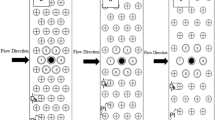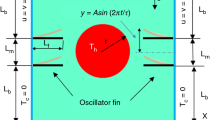Abstract
Failure of tubes in shell and tube exchangers is attributed to flow induced vibrations of such tubes. There are different excitations mechanisms due to which flow induced vibration occurs and among such mechanisms, fluid elastic instability is the most prominent one as it causes the most violent vibrations and may lead to rapid tube failures within short time. Fluid elastic instability is the fluid–structure interaction phenomenon which occurs when energy input by the fluid force exceeds energy expended in damping. This point is referred as instability threshold and corresponding velocity is referred as critical velocity. Once flow velocity exceeds critical flow velocity, the vibration amplitude increases very rapidly with flow velocity. An experimental program is carried out to determine the critical velocity at instability for plain and finned tube arrays subjected to cross flow of water. The tube array geometry is parallel triangular with cantilever end condition and pitch ratios considered are 2.6 and 2.1. The objective of research is to determine the effect of increase in pitch ratio on instability threshold for plain tube arrays and to assess the effect of addition of fins as well as increase in fin density on instability threshold for finned tube arrays. Plain tube array with two different pitch ratios; 2.1 and 2.6 and finned tube arrays with same pitch ratio; 2.6 but with two different fin pitches; such as fine (10 fpi) and coarse (4 fpi) are considered for the experimentation. Connors’ equation that relates critical velocity at instability to different parameters, on which instability depends, has been used as the basis for analysis and the concept of effective diameter is used for the present investigation. The modal parameters are first suitably modified using natural frequency reduction setup that is already designed and developed to reduce natural frequency and hence to achieve experimental simulation of fluid elastic instability within the limited flow capacity of the pump. The tests are carried out first on plain tube arrays to establish the same as the datum case and results are compared to known results of plain tube arrays and hence the quality of the test rig is also assessed. The fluid elastic vibration tests are then carried out on finned tube arrays with coarse and fine fin pitches and effects of fins and fin pitch on instability threshold are shown. The vibration response of the tube is recorded for each gradually increasing flow rates of water till instability point is reached. The parameters at the instability are then presented in terms of dimensionless parameters to compare them with published results. It is concluded that, arrays with higher pitch ratios are unstable at comparatively higher flow velocities and instability threshold for finned tube arrays is delayed due to addition of the fins. Further, it is concluded that, instability threshold for finned tube arrays with fine fin pitch is delayed compared to coarse fin pitch and hence for increased fin density, instability threshold is delayed. The experimental results in terms of critical velocities obtained for different tube arrays subjected to water cross flow will serve as the base flow rates for air–water cross flow experiments to be conducted in the next phase.






Similar content being viewed by others
Abbreviations
- A :
-
Cross section area of recatangular part of the vertical test section (m2)
- a :
-
Exponent of mass damping parameter
- D eff :
-
Effective diameter (m)
- De/D:
-
Confinement factor
- D f :
-
Outside diameter of the fin tube (m)
- d i :
-
Inside diameter of tube (m)
- d o :
-
Base diameter of fin tube (m)
- E :
-
Modulus of elasticity (N/m2)
- f n :
-
Natural frequency in water (Hz)
- h :
-
Fin height (m)
- l :
-
Length of finned portion along the tube (m)
- m :
-
Total mass per unit length (kg/m)
- m h :
-
Hydrodynamic mass (kg/m)
- m t :
-
Structural mass of the tube (kg/m)
- K :
-
Connors’ constant
- fpi:
-
Fins per inches (10 fpi = 2.54 mm and 4 fpi = 6.35 mm)
- P :
-
Pitch of tube array (m)
- P/D eff :
-
Effective pitch ratio
- P/do :
-
Pitch ratio
- p :
-
Fin pitch (m)
- Q :
-
Water flow rate (m3/s)
- V g :
-
Gap velocity based on effective diameter (m/s)
- t :
-
Fin thickness (m)
- V f :
-
Free stream velocity (m/s)
- V pl :
-
Liquid pitch velocity based on base diameter (m/s)
- L :
-
Tube length (m)
- δ :
-
Logarithmic decrement
- ζ :
-
Damping ratio
- ρ :
-
Material density (kg/m3)
- ρ f :
-
Fluid density (kg/m3)
References
X.Yu, An Analysis of Tube Failure in a U-shape Tube Bundle, in ASME PVP Conf., vol. 104 (Chicago, PVP, 1986), 187–197
S.S. Chen, J.A. ZendrzejCzyk, Experiments on fluid elastic instability in tube banks subjected to liquid cross flow. J. Sound Vib. 78(3), 355–381 (1981)
M. Hassan, A. Gerber, H. Omar, Numerical estimation of fluidelastic instability in tube arrays. J. Press. Vessel Technol. 132, 1–11 (2010)
M.J. Pettigrew, C.E. Taylor, B.S. Kim, The effects of bundle geometry on heat exchanger tube vibration in two-phase cross flow. J. Press. Vessel Technol. 123, 413–420 (2001)
M.J. Pettigrew, C.E. Taylor, V.P. Janzen, T. Whan, Vibration behavior of rotated triangular tube bundles in two-phase cross flows. J. Press. Vessel Technol. 124, 144–153 (2002)
P.A. Feenstra, R.L. Judd, D.S. Weaver, Fluid elastic instability in a tube array subjected to two-phase R-11 cross flow. J. Fluids Struct. 9, 747–771 (1995)
P.A. Feenstra, D.S. Weaver, T. Nakamura, Vortex shedding and fluid elastic instability in a normal square tube array excited by two-phase cross flow. J. Fluids Struct. 17, 793–811 (2003)
P. Feenstra, D.S. Weaver, T. Nakamura, Two-phase flow-induced vibration of parallel triangular tube arrays with asymmetric support stiffness. J. Press. Vessel Technol. 131, 1–9 (2009)
V.P. Janzen, E.G. Hagberg, M.J. Pettigrew, C.E. Taylor, Fluid elastic instability and work rate measurements of steam-generator U-tubes in air–water cross flow. J. Press. Vessel Technol. 127, 84–91 (2005)
W.A. Mair, P.D.F. Jonesand, R.K.W. Palmer, Vortex shedding from finned tubes. J. Sound Vib. 39(3), 293–296 (1975)
Hirota K, Nakamura T, Kikuchi H, Isozaki K, Kawahara H, Fluid elastic and vortex induced vibration of a finned tube array, in ASME Proceedings of IMECE 2002, New Orleans, Paper No. 32793, 2002
M. Kienbock, Vibration characteristics of finned tubes with small fins. VGB Kraftwerkstech. 62(7), 498–506 (1982). (English translation)
H. Halle, J.M. Chenoweth, M.W. Wambsganss, Flow-induced tube vibration thresholds in heat exchangers from shell side water tests,in ASME Symposium on Flow-Induced Vibrations, New Orleans, vol. 3, pp. 17–32, 1984
R.H. Lumsden, D.S. Weaver, The effect of fins on fluidelastic instability in in-line and rotated square tube arrays. J. Press. Vessel Technol. 132, 1–6 (2010)
J. Wang, D.S. Weaver, Fluid elastic instability in normal and parallel triangular arrays of finned tubes. J. Press. Vessel Technol. 134, 1–7 (2012)
H.J. Connors, Fluid-elastic vibration of tube arrays excited by cross flow, Flow -Induced Vibration in Heat Exchangers (ASME, New York, 1970), 42–56
S.J. Price, An investigation on the connors' equation to predict fluidelastic instability in cylinder array, J. Press. Vessel Technol. 123, 448–453 (2001)
H.J. Chung, I.C. Chu, Fluid-elastic instability of rotated square tube array in an air-water two phase cross flow. Nucl. Eng. Technol. 38(1), 69–80 (2006)
D. Mitra, V.K. Dhir, I. Catton, Fluid elastic instability in tube arrays subjected to air–water and steam-water cross flow. J. Fluids Struct. 25, 1213–1235 (2009)
F.K. Shami, A.H. Qureshi, M. Mansha, Importance of added mass and damping in flow-induced vibration analysis of tube bundle: an overview. Mehran Univ. Res. J. Eng. Technol. 31(1), 29–38 (2012)
Kistler_8778A500 Ceramic Shear_Accelerometer, Data Sheet, Kistler Instrument Corporation, USA, 2008
DEWESoft 6.3 with DEWETRON Hardware and DAQP Charge Amplifier, User’s Manual, Austria, 2005
M.J. Pettigrew, C.E. Taylor, Fluidelastic instability of heat exchanger tube bundles: review and design recommendations. J. Press. Vessel Technol. 113, 242–256 (1991)
Acknowledgment
The authors gratefully acknowledge the financial assistance provided for experimentation on fluid elastic vibrations by A.I.C.T.E., New Delhi under Research Promotion Scheme (R.P.S.). The authors are also thankful to McMaster University and express their sincere thanks to undergraduate and postgraduate students for their timely help.
Author information
Authors and Affiliations
Corresponding author
Rights and permissions
About this article
Cite this article
Desai, S.R., Pavitran, S. The Effect of Fin Pitch on Fluid Elastic Instability of Tube Arrays Subjected to Cross Flow of Water. J. Inst. Eng. India Ser. C 99, 53–61 (2018). https://doi.org/10.1007/s40032-016-0332-z
Received:
Accepted:
Published:
Issue Date:
DOI: https://doi.org/10.1007/s40032-016-0332-z




